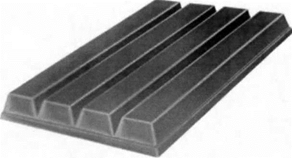

CJEU: Preliminary ruling on questions relating to protectability of the Kit Kat shape
October 27, 2015
Categories:
Post date:
27. October 2015 - 15:32
The Court of Justice of the European Union (CJEU) has given a preliminary ruling on questions relating to Nestlé’s three-dimensional trademark application representing the shape of a four finger chocolate-coated wafer without the embossed words Kit Kat. The questions were forwarded to the CJEU by English courts (Case C‑215/14 Judgement of 16 September 2015).
Background of the case and subject matter
The product was placed on the market in the United Kingdom in 1935; in 1937 the name of the product was changed to ‘Kit Kat Chocolate Crisp’, and then shortened to ‘Kit Kat’. In 1988 the company was acquired by Nestlé.
On 8 July 2010 Nestlé filed an application (No.: UK00002552692) for registration of the three-dimensional sign as a trade mark in the United Kingdom in respect of the following goods in class 30: ‘Chocolate; chocolate confectionery; chocolate products; confectionery; chocolate-based preparations; bakery goods; pastries; biscuits; biscuits having chocolate coating; chocolate coated wafer biscuits; cakes; cookies; wafers’.
The Trade Marks Registry of the United Kingdom Intellectual Property Office accepted the application. However, on 28 January 2011, Cadbury filed a notice of opposition to the application for registration. The examiner of the United Kingdom Intellectual Property Office found that the trade mark at issue was devoid of inherent distinctive character and rejected the application in respect of all goods except ‘cakes’ and ‘pastries’.
Both Nestlé and Cadbury appealed against the decision. The High Court of Justice of England & Wales referred the following questions to the Court of Justice for a preliminary ruling:
- In order to establish that a trade mark has acquired distinctive character following the use that had been made of it within the meaning of Article 3(3) of Directive 2008/95 ..., is it sufficient for the applicant to prove that at the relevant date a significant proportion of the relevant class of persons recognise the mark and associate it with the applicant’s goods in the sense that, if they were to consider who marketed goods bearing that mark, they would identify the applicant; or must the applicant prove that a significant proportion of the relevant class of persons rely upon the mark (as opposed to any other trade marks which may also be present) as indicating the origin of the goods?
- Where a shape consists of three essential features, one of which results from the nature of the goods themselves and two of which are necessary to obtain a technical result, is registration of that shape as a trade mark precluded by Article 3(1)(e)(i) and/or (ii) of Directive 2008/95 ...?
- Should Article 3(1)(e)(ii) of Directive 2008/95 ... be interpreted as precluding registration of shapes which are necessary to obtain a technical result with regard to the manner in which the goods are manufactured as opposed to the manner in which the goods function?
- Article 3(1)(e) of Directive 2008/95/EC must be interpreted as precluding registration as a trade mark of a sign consisting of the shape of goods where that shape contains three essential features, one of which results from the nature of the goods themselves and two of which are necessary to obtain a technical result, provided, however, that at least one of the grounds for refusal of registration set out in that provision is fully applicable to the shape at issue.
- Article 3(1)(e)(ii) of Directive 2008/95/EC must be interpreted as referring only to the manner in which the goods at issue function and it does not apply to the manner in which the goods are manufactured.
- In order to obtain registration of a trade mark which has acquired a distinctive character following the use which has been made of it within the meaning of Article 3(3) of Directive 2008/95, regardless of whether that use is as part of another registered trade mark or in conjunction with such a mark, the trade mark applicant must prove that the relevant class of persons perceive the goods or services designated exclusively by the mark applied for, as opposed to any other mark which might also be present, as originating from a particular company.
Related
- "Neuschwanstein" is not a trademark!
- 1 December 2017: Madrid Monitor takes its place as the one and only tool for tracking international trademarks
- 1 January 2020 - Changes in Classifications - Trademarks, Designs, Patents and Utility Models
- 100th Anniversary of Bavaria (Germany) - A glance at trademarks, start-ups, innovation & events
- 10th Anniversary Edition - 10 Things to Know about LexDellmeier - Past, Present & Future
- 14 June 2013: Munich Patent Law Conference - Calculating Damages in Patent Infringement Cases
- 15 Top Brands - Interactive Brand Rating - Years 2000 - 2018
- 15 Years LexDellmeier - 2024 New Year Wishes
- 2014: Statistics for Community Trademarks
- 2024 World IP Day - Building Our Common Future with Innovation and Creativity
